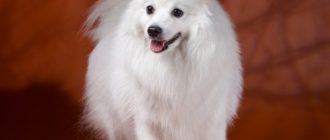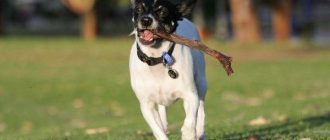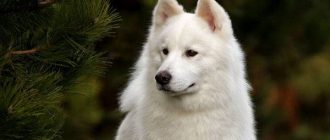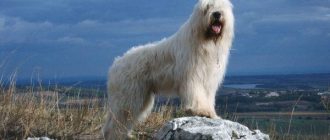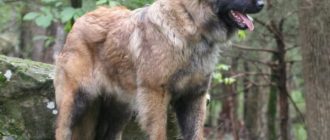Assessment of breed characteristics
Contents
| Adaptability Definition of how easy a dog is. can adapt to changes in life. |  |
| Shedding Level Level and frequency of hair loss in animal. |  |
| Level of tenderness Level and amount of tenderness and affection that the dog gives back in return for attention to itself. |  |
| Need for Exercise Daily Activity Level dogs. |  |
| Social need Required number of dog contacts with other animals as well as people. |  |
| Housing ratio Factor that determines the level of noise and other inconvenience that the dog can deliver to the owners in the ratio apartment size to dog size. |  |
| Grooming Number of bathing, combing, as well as necessary number of professional grooming sessions required the dog. |  |
| Friendliness in an unfamiliar environment society with strangers or in an unfamiliar environment. |  |
| The tendency to bark The tendency to bark and its frequency and volume. |  |
| Health Issues Potential Health Status dogs. |  |
| Territorial tendency of the dog to protect his house, yard or even a car owner. |  |
| Cat friendliness A trend towards cat tolerance and reduced manifestation of hunting instincts. |  |
| Intelligence Dog’s ability to think and solve emerging difficulties (not to be confused with learning!). |  |
| Education and training Level of difficulty in training a dog perform certain actions. |  |
| Friendliness for children Factor determining how much the dog friendly to children, whether she likes to play with them and endure some children’s pranks. |  |
| Game activity The concept is determined by its very name, and, usually found in almost all dogs. |  |
| Observing Dog’s ability to detect presence a stranger in his territory. |  |
| Friendliness for other dogs Dog’s tendency to find common language with other relatives. |  |
Brief description of the breed
Russian hound is a favorite breed of Russian hunters. Thanks their stamina and ability to pursue game for a long time, and also in a clear voice, the Russian hounds are indispensable during the hunt for wolves, foxes, hares. Finding the trail of the animal, the Russian hound chases, continuously barking, so she notifies the owner about successful pursuit of the beast. These dogs are so desperate that able to follow even very large animals – bears, wild boars. Russian hounds are distinguished by unprecedented anger for game and ability to tirelessly help the owner in the prey of the beast. Fearlessness, sharp scent and excellent vision allow Russian hounds to be unsurpassed hunters. Dogs of Russian hounds reach at the withers 58-68 cm, bitches – 55-65 cm. The weight of the dogs ranges from 25-30 kg The addition of animals is strong, muscular, with a well-developed skeleton. The skull of the dog is relatively small (due to the developed torso), wedge-shaped, elongated muzzle. Russian hounds neck dry, short length. The body is muscular, the back is straight, the stomach picked up. The tail is saber-shaped, tapering to the bottom. Limbs straight, bony. Characteristics of the dog – hanging ears triangular shape, well-developed large teeth (bite scissor-shaped), eyes almond-shaped brown shade. Color Russian hounds black, crimson, white with red and black marked or gray with light tan marks, areas of limbs and the abdomen is overwhelmingly white. Wool on head, ears and paws shortened, on the back, neck and hips somewhat longer, undercoat is soft, thick. Russian hounds are often compared with a wolf thanks to the manner of holding his head low, and also because similarities in the figure – the body is reduced to the croup, which makes the area chest and forepaws visually longer and taller. Duration the life of dogs of this breed is 10-12 years. Russian hound depends on its belonging to a certain class:
- Pet class – animals with all the best qualities breeds, but having some flaws in appearance. Puppies Pet class can not claim to participate in exhibitions, but perfectly cope with hunting duties. Puppy cost this level is approximately 100 cu;
- Brid-class – animals that do not have gaps in the genetic recruitment and serious shortcomings, they can participate in exhibitions, but rarely take first place and are rated highly. Cost such puppies ranges from 300 to 500 cu;
- Show class – dogs with a perfect exterior, habits, their The characteristics are fully consistent with the breed standard. Such animals are acquired for the purpose of participating in exhibitions and for breeding. The price of show class puppies can be over 1000 cu, such dogs, as a rule, are not acquired only for hunting, since their maintenance at the proper level is very considerable money.
Sometimes hunters prefer to get an adult from a breeder an individual trained and familiar with all the intricacies of game hunting. IN in this case, the owner takes a minimum of time to educate the dog, however, you have to make contact with a dog that has its own habits. Since Russian hounds must obey strong-willed and sufficiently tough (not cruel) person, it should be understood that get along with a dog actually raised by an outsider it will not be easy.
Photo of the Russian hound:
Photo of dogs of the Russian Hound breed |
Origin history
The first mention of ancient Russian hounds dates back to the 11th century. The true heyday of hunting dogs, including Russian hounds, It began after the 15th century, when in Russia be interested in dog hunting. Wealthy Kennel Owners of time were called Russian hounds by yapping due to loud a barking bark during a baiting game. It is believed that the ancestors Russian hounds were medelyanki (now extinct Old Russian breed large dogs whose purpose was bullying and bear hunting) and Tatar hounds. The popularity of Russian hounds led to unsystematic crossing, which significantly affected the appearance and the nature of the puppies. Proceedings of breed researchers related to 18-19 centuries, include so conflicting facts regarding the uniform appearance of dogs, that there is every reason to believe that Russian hounds until a certain time called many hunting dogs with a similar character, but completely different in external characteristics. Only by the 19th century did the situation with the appearance and habits began to accept a certain stability. Russian hounds were good at chasing game alone and in pairs as well along with greyhounds. These dogs have always been unprecedented stamina, refusal of food and rest, if required Tracking and chasing the beast. The first breed standard was bred in 1895. Since the end of the 19th century, the popularity of Russian hounds eclipsed by the english foxhounds, many hunters considered these dogs more successful during the hunt, which gave inspiration to create a new breed – the English-Russian hound, which is also called Russian pinto hound. Often representatives of these breeds confused, indeed, in appearance they are similar, the differences are only in color and sonority of voices, as well as some details not very noticeable ignorant person. However, for the climate and features of the territories Russian hound, whose history is more suitable for our country creation goes back to ancient times. In European countries, the Russian hound does not has special popularity, while in our country avid hunters have the honor of taking this dog as companions.
Character of Russian hound
Russian hounds are quite friendly not only to the owner, but also to other family members. In some cases, when the animal was not well trained, the dog becomes somewhat aggressive towards other pets. That’s why giving attention to a dog of this breed is from a very young age. Russian hounds are smart enough, unobtrusive, very active and energetic. As a host for such a dog is ideal hunted man with a strong-willed and strong character, because this breed instantly tries to dominate, only smells relief in relation. They lend themselves well to training, the main thing – find the right approach. Such animals love active spending time, but in the absence of the possibility of the owner play will not bother and require attention to their own person.
Maintenance and care
Russian hounds do not require special care. All care procedures come down to regular combing of wool. During molting should comb out daily to save the dog from dead hairs. Dog bathing should not be practiced too often. It will be enough 2-3 times a year. These dogs are pretty neat and neat, which, of course, plays them only a plus. Accommodation dogs in an apartment (especially a small area) are undesirable, since the Russian hound needs enough space for games and entertainment. Therefore, an ideal option would be the settlement of the animal in a sufficiently large aviary with a booth on the territory of a private or country house. An indispensable condition for keeping such a dog are daily long walks. Man not having enough time for walking, training and providing active spending time to the dog is unlikely should start a Russian hound. Feeding dogs breed Russian the hound does not have any features. If the owner considers possible to cook the dog yourself, then the basis of nutrition is meat, offal, cereals and vegetables, dairy products. You should never feed the Russian hound with food from the table, since food prepared for people contains a large amount of harmful constituents (seasonings, spices) may be too oily, sweet. Hard tubular bones to prevent damage to organs digestion should also not be given to the dog. When feeding natural foods should take care of the introduction of vitamins in the diet dogs, especially in the spring and autumn. Good an alternative to food prepared by the caring hands of the owner, is a finished industrial feed. Such a choice would be good in in the case when its quality will not be lower than the premium class.
Training and training
Dog training elementary teams should begin no later than 3 months of age. The dog must know its own nickname, commands “Fu”, “You can’t,” “To me,” “Sit,” and others. As encouraging puppy should apply gentle intonation when pronunciation of a word of praise (for example, “Well done”) and treat dog treat. As punishment should never be applied physical strength and aggressive tone. Russian hounds are very smart and quickly grasp the words of the owner. To do this, find the right approach – the owner must show the dog his superiority over her. Since Russian hounds are overwhelmingly acquired as hunters, some nuances of their education should clearly perceived by the owner. For example, feeding a dog should occur after the sound of a hunting horn, which will greatly simplify dog life in the future. Before signaling, the hunting dog does not should eat not a bit of food from a bowl. Walks and outings on nature is mandatory for hounds, a dog from an early age should know the features of the terrain in which thereafter to hunt. The dog must clearly understand which animals are not must suffer from her innate desire for hunting. Obligatory quality of Russian hounds – unconditional obedience the owner. If training puppies comes down to instilling simple and necessary teams, then the real training goes according to all the rules. In the process of training, the animal learns hunting skills, which are improved with each successful match against the wild beast.
Health and Disease
To the main diseases characteristic of Russian hounds relate:
- Degenerative myelopathy is a progressive disease spinal cord (most often in older dogs). The main symptoms – a change in gait, dog croup wags from walking side to side, weakness. The dog can become immobilized, the disease process affects the functioning of the intestines and urinary bladder, which leads to incontinence of feces and urine;
- Hip dysplasia – underdevelopment of the joints, which entails impaired musculoskeletal system dogs. Owners should be wary of lameness, fatigue, weakness of the hind limbs of the dog;
- Myositis is an inflammation of muscle tissue. Temperature appears fever, the animal experiences severe pain when touching place of inflammation. Myositis affects the muscles of the neck, shoulder, back, loins, hips.

